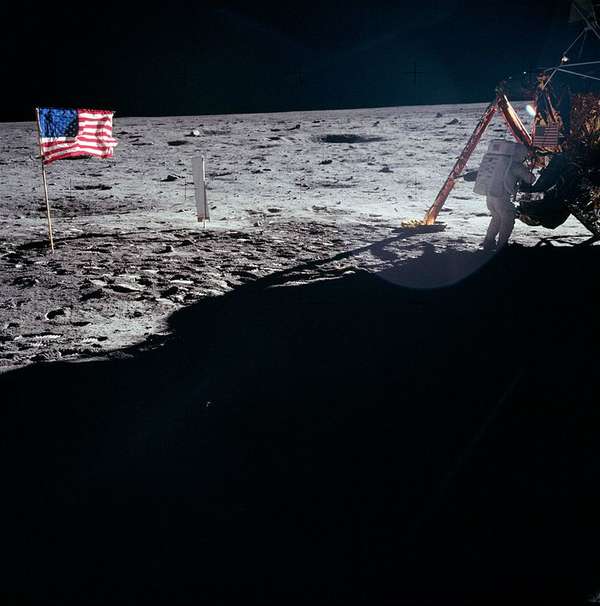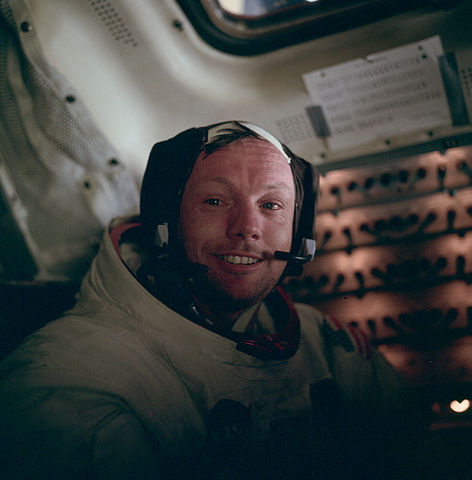A small step for [a] man – From Germany to the moon
- 25. August 2017 - Emigration, General, German-American, Historical Events, Knowledge, Personalities
The first man on the moon, a German? No, of course not. But Neil Alden Armstrong had indeed German ancestors.
He was born on 5 August 1930 in Ohio and died in the same state on 25 August 2012 when he was 82 years old. Inbetween Neil Armstron made history with one step on 20 July 1969 (American time). It is not surprising that Armstrong, sometimes compared to Columbus, descended from immigrants as most Americans do. His ancestors had the courage to take steps on unfamiliar ground. To start all over in a new country was certainly not an easy thing to do. Especially as keeping in touch with the people that stayed behind wasn’t as simple as today.
Neil Armstrong’s German roots
Stephen Koenig Armstrong, Neil Armstrong’s father, had mostly Scottish-Irish ancestors, but some maternal grandparents were of German origin. Neil Armstrong’s great-grandfather Jacob Koenig had emigrated from Germany to the US and his great-grandfather Adam Hoppel was probably German as well.
But it is especially his mother’s side that links Neil Armstrong to Germany. Viola Louise Engel, as was her maiden name, was the granddaughter of Friedrich Wilhelm Kötter who was born on 22 August 1846 in Ladbergen as the fourth child of a farmer. This Friedrich Kötter emigrated in 1864, when he was only 18 years old, from Ladbergen in todays North Rhine-Westphalia via Amsterdam to the US. As many other emigrants at the time, he probably had economic reasons to leave Germany as well as an impending military obligation he wanted to avoid.
Many people of Ladbergen ended up in New Knoxville, Ohio. Kötter settled in the area as well. He married Mary-Martha Kötterheinrich, the American born daughter of a married couple that also immigrated from Ladbergen. And he established a farm in nearby Wapakoneta. On this farm, Neil Armstrong was born in 1930 as the great-grandson of the immigrant.
Neil Armstrong never visited Ladbergen, although he did know about his German ancestors there.
A life for flying
Apparently Armstrong was fascinated by flying early on. Even before he had a driver’s licence, he got a pilot’s licence. In 1947, he started to study Aeronautical Engineering at Purdue University with a Navy scholarship. In 1949, Neil Armstrong was enlisted by the Navy and trained to be a fighter pilot. From 1950 to 1952 he fought in the Korean War. After his return, he continued to study and graduated as Bachelor of Science in 1955. Subsequently Armstrong became a test pilot at the National Advisory Committee for Aeronautics (NACA), a predecessor of the NASA. In 1962, he switched to the space program and became command pilot of the Gemini 8 mission in 1966, docking for the first time two vehicles in space successfully.
After landing on the moon with Apollo 11 in 1969, Armstrong retired from public life. In 1970, he became Deputy Associate Administrator for Aeronautics at the NASA Headquarters in Washington, D.C. and finished his Master of Science in Aerospace Engineering at the University of Southern California in Los Angeles. He left the NASA in 1971. Afterwards, he became a professor of Aerospace Engineering at the University of Cincinnati until 1979 and subsequently entered the business world. He furthermore was a member of several committees.
It seems as if Neil Armstrong felt a litte uncomfortable with the fame for his walk on the moon. He was aware that he had been lucky to be selected and that many thousand people had a share in making the mission successful. Still, he will probably always be famous for this one first step as well as his words about it. And rightly so, for the pictures of this major media event kept people all around the world in suspense and allowed them to dream. And not least, they were an important milestone in the Cold War.



0 comments